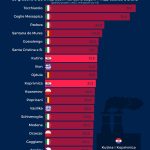Its main view is that the level of taxation should be proportionate to the level of damage caused by the use or consumption of a particular product. In his opinion, banning such products would be very difficult, and perhaps unnecessary. He illustrates this with the example that driving a car is definitely a pollutant, but he points out that it brings huge economic and social benefits.
Professor, we followed with interest your presentation and discussion at the Tax Conference. Although in general we all somehow believe that the role of excise duties is mostly in the service of collecting budget revenues, this is not really the case, but the social implications are far greater. In the light of the proposed Energy Tax Directive (ETD) and the upcoming Tobacco Tax Directive (TED) review can you briefly comment and clarify how we should look at the overall effects of excise duties?
Excise duties are surely important as a source of State’s revenue. I believe that in Croatia they account for about 5% of total government revenues, and that the majority of these revenues come from excise duties on fuel. Excise duties do serve a purpose to collect revenues, but also to affect consumption behavior of harmful products, whether it is because of pollution, addiction, or adverse health outcomes. We should not forget that the government can achieve both revenues and behavioral effects through taxation. This is particularly important when talking about the ETD and the TED, since in both cases excise duties can contribute in nudging consumers towards better products, improving the overall system. And they can do so while achieving revenues. In the case of the Energy Tax Directive, that’s precisely what the Commission is trying to do with its proposal. This is a modern approach, directed to produce positive behavioral effects I am talking about.
Most excise goods, or their use, have either health or environmental implications. Is the solution in eliminating the consumption of such products? How would this reflect on the overall social and economic aspect of society and is something like that realistic at all?
Eliminating consumption of this products may be very difficult, and may also not be necessary or useful. Surely driving cars pollutes, but it also brings to immense economic and social advantages. Similarly moderate consumption of alcohol or sugar need not be detrimental for one’s health. Also for tobacco products, because of their addictiveness and their entrenchment in our culture, it may not be feasible to ban them altogether. We also have to take into consideration the effect that a total ban may have on illegal supply channels. This is not something new. In fact, we have observed throughout history. Think about the classic example of prohibitionist in the US. All in all, it is probably more realistic to try to push consumers away from unhealthy habits through taxation and information campaigns.
Products evolve taking into account consumer preferences and trends. The same goes for excise products. For example, people are increasingly looking for electric cars that are less harmful to the environment or looking for less harmful substitutes for smoking. How should, in your opinion, an excise policy be set in relation to the level of product harmfulness?
Basic economic theory tells us that harmful products – i.e products that create a negative externality or internality – may be taxes in order to correct for the fact that producers and consumers do not fully take into account the harm done by these products. This also implies that the level of taxation ought to be commensurate to the level of harm and the elasticity of supply and demand, i.e. how much consumers and producers are affected by a change in price. In layman terms: if a product is highly damaging, it should be taxed in a heavy way. If it is less damaging, it should be taxed less.
Are there any examples that you would point out that should take into account the relationship between harmfulness and excise policy?
In many markets excise policy takes this relationship into account: typically spirits are taxed more than beer and wine; road tax is often linked with the level of emission of a car (and therefore their harmfulness); also in sugar-sweetened drinks tax is proportional to the amount of added sugar. In this sense if would be desirable that also in the broad nicotine and tobacco market products may be taxed according to their level of harmfulness, following a risk-based taxation, with traditional cigarettes taxed more than other innovative products.
To what extent does legislation follow rapid changes in product development and consumer preferences? Is anything happening at the moment on this issue at the level of nation states or supranational levels?
Legislation is typically slow in this. As new products start with small market shares, they are initially ignored by governments. Take for example nicotine products – as innovative nicotine products are gaining popularity, more and more government have taxed them in very heterogeneous ways. The EU directive that informs all national regulations is also 10 years old, and was written before all of these new products were relevant. In the next months this EU directive will be updated also to encompass these products among others. On the energy front we are seeing some very good steps in the right direction, with the application of behavioral principles to taxation.
You have worked on certain models and economic analyses concerning the principle of harm reduction. In that sense, what would you point out as your conclusions and thoughts?
My main point is that taxation levels should reflect harmfulness, also so that consumers that choose to consume more harmful products may be pushed towards less risky alternatives. This is true in every industry. From cars to food and with everything in between. In the case of tobacco, this approach would help to decrease smoking prevalence while simultaneously preserving government revenues and improving the health and social outcomes.
For more, check out our business section.










